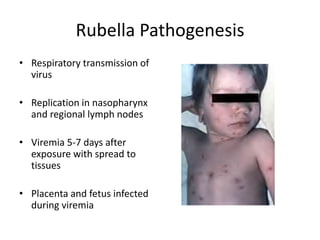Rubella infection
- 2. Rubella Virus âĒ From Latin meaning âlittle redâ âĒ Acquired rubella; German measles; 3-day measles âĒ Caused by an enveloped, single stranded RNA virus of the Togaviridae family âĒ Highly contagious and transmitted through respiratory secretions âĒ Occurred most often in childhood
- 3. Rubella Pathogenesis âĒ Respiratory transmission of virus âĒ Replication in nasopharynx and regional lymph nodes âĒ Viremia 5-7 days after exposure with spread to tissues âĒ Placenta and fetus infected during viremia
- 4. Individuals requiring rubella immune status determination: âĒ Preschool-age and school-age children âĒ All females at or just before childbearing age âĒ Women about to be married âĒ Married woman âĒ Pregnant woman âĒ Health care personnel
- 5. Clinical Features âĒ Incubation period 14 days (range 12-23 days) âĒ Prodrome of low grade fever âĒ Lymphadenopathy in second week âĒ Maculopapular rash 14-17 days after exposure
- 6. âĒ Koplik spots are seen with measles. They are small, white spots (often on an reddened background) that occur on the inside of the cheeks early in the course of measles may appear as irregular red spots with a minute, bluish white center opposite molars 2 days before rash
- 7. Congenital Rubella Syndrome âĒ Infection may affect all organs âĒ May lead to fetal death or premature delivery âĒ Severity of damage to fetus depends on gestational age âĒ Up to 85% of infants affected if infected during first trimester
- 8. Fetal abnormalities associated with maternal rubella infection: âĒ Encephalitis; âĒ Hepatomegaly; âĒ Bone defects; âĒ Mental retardation; âĒ Cataracts ; âĒ Thrombocytopenic purpura; âĒ Cardiovascular defects; âĒ Splenomegaly; âĒ Microcephaly
- 10. Diagnostic evaluation 1. Hemagglutination Inhibition (HAI) âĒ Most frequently used method of screening for the presence of rubella; reference method âĒ Disadvantage: it can detect a combination of IgM and IgG antibodies but it does not distinguish between them 2. Enzyme immunoassay for Antibodies âĒ The rubella-specific IgM often persists for 20 to 30 days after acute infection or vaccination and also in infants with congenital rubella
- 11. 3. Latex agglutination âĒ Provide more rapid and convenient alternatives for HAI âĒ Positive result: visible clumps âĒ Negative result: latex particles are remain smooth and evenly dispersed âĒ Single specimen are required for qualitative determination of antibody levels âĒ Two specimens for quantitative testing
- 12. âĒ The first specimen should be collected within 3 days of the onset of rash or at the time of exposure and tested on arrival in the laboratory âĒ 2nd specimen is collected 7 to 21 days after the onset of tha rash or at least 30 days after exposure if no clinical symptoms occur. âĒ 2 ml of blood collected in red top evacuated tube âĒ Specimens maybe stored up to 48 hours at 2-8 degree C âĒ Sodium azide preservative present in latex reagent, buffer and control
- 13. âĒ 4. Flourescent immunoassay âĒ Qualitative test card â Used to detect the presence of rubella antibody












